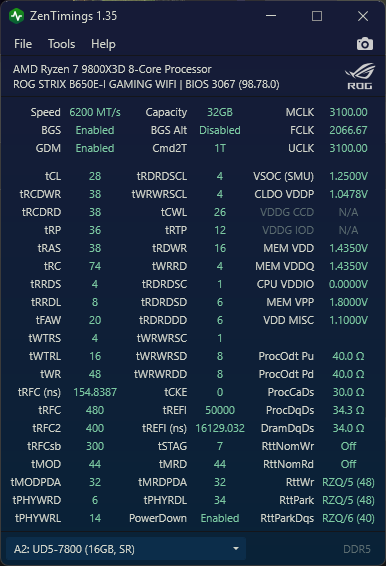/9800X3D Mayhem
Diminishing Returns
from 01/18/2025, by uni — 6m read
Finally, I get to play with my new toy. After spending my winter break in Brazil, I came home to unbox my AMD 9800X3D and ASUS B650E-I. I'll admit upfront - I knew this upgrade would be overkill for my use case, but I've wanted to try a 3D V-Cache chip ever since the 5800X3D was released. Upgrading from a 12700K with 7200 MHz CL30 RAM, I was already getting solid performance in my game of choice, CS2.
Getting my hands on the chip was a challenge. Since its release on November 7, I'd been refreshing Amazon, Newegg, and B&H product pages nonstop while keeping an eye on r/buildapcsales. Eventually, I gave in and resorted to a bot. Using HotStock, I finally secured the CPU in just a couple of hours.
While in Brazil, I waited patiently for motherboard manufacturers to announce their B850I boards at CES. My patience eventually wore thin, so I ordered the B650E-I, knowing it was already one of the best AM5 ITX boards, comparable to the B850 chipset. Ironically, the day after I placed my order, the B850I version was announced. Annoying, but it didn't ruin the excitement. The B850I's additions - an extra 5.0 NVMe slot and WiFi 7 - are things I didn't really need.
The Build Process
I had the pleasure of building my PC with my friend Joseph, who helped me fit everything into my Formd T1 case. We had doubts about squeezing it all in, but we managed (mostly). The AIO's tubes press hard against the side panel, and I've removed the right panel altogether to avoid fan turbulence on my ASUS 4080 ProArt.
Once the system was up and running, I was eager to start tuning the chip. Using an ASUS board for the first time, I was pleasantly surprised by how intuitive their BIOS was. Here are the initial settings I changed:
- Precision Boost Overdrive: Enabled
- Curve Optimizer: -30 All Cores
- CPU Boost Clock Override: +200 MHz
- Memory Frequency: 6000 MHz
- FCLK Frequency: 2000 MHz
- ASUS Armoury Crate: Disabled
(Quick side note: I didn't know motherboards could auto-install software. How annoying!)
The system was surprisingly stable with these PBO settings - almost too good to be true - without touching voltages. Naturally, I decided to push things further and try 6400 MHz for my RAM.
- Memory Frequency: 6400 MHz
- FCLK Frequency: 2133 MHz
- UCLK DIV1 MODE: UCLK=MEMCLK
- DRAM Voltage: 1.35V
Calculating FCLK:
FCLK = (RAM Frequency / 2) * (2 / 3)
FCLK = 3200 * (2 / 3) = 2133
Booting into 6400 MHz RAM on the 9800X3D meant I had a golden chip - it worked on the first try! Using BenchMate, I hit 23,000 points in Cinebench R24, breezed through y-cruncher benchmarks, and remained stable in CS2 warmup servers. It felt unstoppable, passing a one-hour TestMem5 stability test.
A Day of Frustration
The next day, I decided to tighten my RAM timings to maximize performance. I used Buildzoid's "Low Effort DDR5 Timings" as a baseline, but stability testing failed within minutes. For an entire day, I tinkered with voltages, timings, and settings but couldn't pass any stability tests. I was exasperated.
Eventually, I reset the BIOS to stock settings, only to find the system failing even then. That's when I realized the BIOS was dated 2024/10/22, predating the 9800X3D release. After installing the latest December BIOS update, the stock settings were stable again (let's just ignore that they were fine the day before).
Final Stable Settings
Now with stability restored, I settled on 6200 MHz RAM, as my chip's IMC seemed insufficient for 6400 MHz. The difference was minimal anyway. Here are my validated settings after a four-hour TM5 pass:
- Precision Boost Overdrive: Enabled
- Curve Optimizer: -25 All Cores
- CPU Boost Clock Override: +150 MHz
- Memory Frequency: 6200 MHz
- FCLK Frequency: 2066 MHz
- CPU SOC Voltage: 1.25V
- DRAM Voltage: 1.44V

Switching Core Tuning Configuration from Auto to Legacy reduced my AIDA latency by 5 ns, dropping it from 68 ns to 63 ns. Small tweaks like this made a noticeable difference.
In-Game Performance
Before swapping out my 12700K, I ran one last benchmark using FPSHeaven's CS2 FPS BENCHMARK. While I'm not a fan of FPSHeaven's paid services, this map is useful for its intended purpose. I kept my video settings the same throughout (1280x960 stretched, all high).
Results:
12700K + 7200 MHz RAM
[VProf] -- Performance report --
[VProf] Summary of 50482 frames and 115 1-second intervals.
[VProf] FPS: Avg=441.3, P1=174.3
9800X3D Stock + 6000 MHz CL30 RAM
[VProf] -- Performance report --
[VProf] Summary of 64279 frames and 113 1-second intervals.
[VProf] FPS: Avg=580.9, P1=220.7
9800X3D Tuned + 6200 MHz CL28 RAM
[VProf] -- Performance report --
[VProf] Summary of 72606 frames and 115 1-second intervals.
[VProf] FPS: Avg=634.8, P1=250.3
The 9800X3D at stock settings is 31.6% faster than my previous build - insane! I could have stopped there after applying a simple undervolt and negative CO offset. However, by tuning my system, I squeezed out an additional 9.2%. Even the 1% lows are higher than my monitor's refresh rate. This level of performance is just plain stupid.